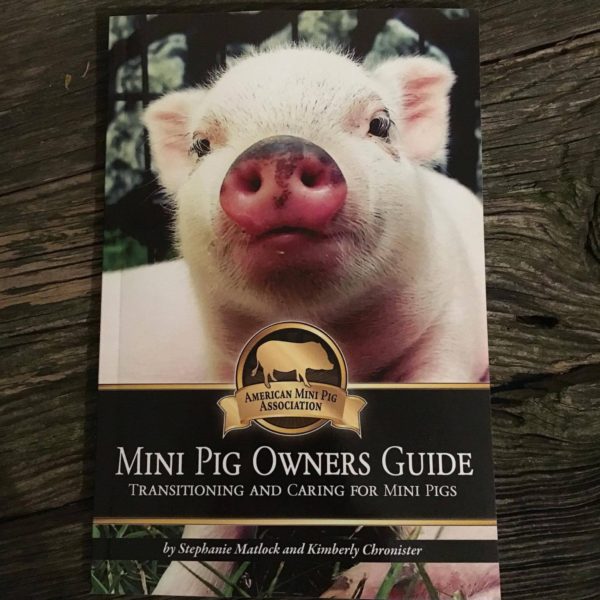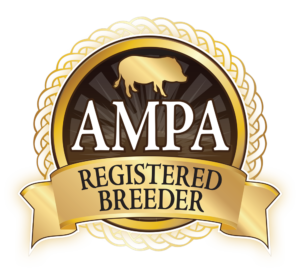Basic Skills and Training for Mini Pigs
There are a few basic skills and training for mini pigs that you need to have a well-mannered, easy to control pet. Teaching your pig commands,  tricks, and basic skills at a very young age will set him or her up for success. You are teaching them the things that you will need from them to keep them safe and happy and in effect keeping the family proud and in control. The AMPA Mini Pig Training Handbook goes home with every one of our piglets and can find your copy here.
tricks, and basic skills at a very young age will set him or her up for success. You are teaching them the things that you will need from them to keep them safe and happy and in effect keeping the family proud and in control. The AMPA Mini Pig Training Handbook goes home with every one of our piglets and can find your copy here.
Pigs are highly motivated by food. Teaching tricks and skills are simple with a small, easy to handle and quick to eat reward such as air-popped non-salted, non-buttered popcorn, cheerios, shredded wheat, small bite of apple, quartered or halved grape.
Pigs thrive on routine. Training time should be a specific time every day when your pig seems most focused. Not before meal time or when your pig is hungry. Training sessions before bedtime give your pig a great physical and mental workout for a restful night of sleep.
The Command Come
One of the most important of the basic skills is to teach your mini pig to come. This training starts as easily as speaking the word “Come” every time you offer your pig their meals. Start this day one with your pig and repeat any time a treat is offered or food is given for a couple of days. Start calling for your pig to come from farther and farther distances while rewarding with praise or a healthy treat each time the pig obeys. Fewer and fewer treats and more praise as the days follow and your pig should have this mastered in no time. This command mastered will make harness and leash training much faster and less stressful. The American Mini Pig Association has a great article on recall you can find here.
SIT
 Teaching your pig to sit may be slightly more challenging, but can also be taught quickly. It’s a good skill to build on in future training. You may eventually want your pig to sit quietly to wait for his meals. To teach sit make sure your pig is on carpet or an area rug so that his feet won’t slip out from under him.
Teaching your pig to sit may be slightly more challenging, but can also be taught quickly. It’s a good skill to build on in future training. You may eventually want your pig to sit quietly to wait for his meals. To teach sit make sure your pig is on carpet or an area rug so that his feet won’t slip out from under him.
Get you pig familiar with the treats/reward. Show the pig your reward and lift it in front of their snout and slowly up and over the head. Your pig should raise its snout following the treat. Watch the pigs snout, say “sit” and slowly continue to raise it until the pigs bottom hits the floor. Timing is critical so be sure you reward as soon as that butt hits the floor. Some find it is easier to accomplish a full sit by having their pig close to a wall or in the corner. Some pigs may not respond well if they feel cornered or trapped against a wall. Once the pig’s bottom hits the floor say “sit” and praise, praise, praise and reward with the treat.
NO
Obviously, the command NO is going to be used often. Pigs learn these short commands easily and fast, so only use NO when it’s really needed. Positive reinforcement “good pig” and praise for good behavior can go far in training your pig. You can use other methods of showing your pig incorrect behavior in a number of ways. A loud, firm NO with a stop sign hand or finger pointing will show your pig that you are not pleased with its behavior. Eventually, just raising that stop sign hand or finger may be all you need to get your pigs attention.
Back, Leave It or Out
Back or Leave it can be very helpful for a couple of reasons. If you pig is in an area that he or she shouldn’t be or if they are interested in something that they shouldn’t be then the Back or Leave it command should cause your pig to do just that, back away or leave it. Teaching this will require a good reading of your pig’s body language. When your pig steps into an area, such as the kitchen which may be off limits, you need to say the command and use your body moving toward the pig to make the pig step back. Say “back, back” or “out” with every step and then praise. Start with a couple of steps back from your pig and gradual increase to a few, praising as you go. Soon, just saying the word back should cause steps back from your pig, however you may have to reinforce the training by moving forward a step or two every once in a while.
Wait or stay can be a little more challenging to teach because the pig is going to want to scamper to the treat so keep the reward hidden. Have your pig sit and then repeat “stay” with a hand gesture or finger point, which ever hand signal you are not using for “No”. After the pig has sat still for a moment or two, praise and reward. Each time waiting longer and longer before rewarding. Gradually, start taking steps back with a reminder of “stay”, then return to your pig with praise and reward. Stay can be a little easier to maintain if the pig knows you come to them for reward as opposed to them running to you. This one will take some time, patience and extra practice.
Spin, Dance, Left/Right
This trick can be called a few names. It is basically your pig turning in circles for the reward going to the left or right. You can teach this one easily by using your visible reward overhead moving in a large circle guiding your pig to use his feet to turn. Some say “spin” and some use “left”, “right” as they guide the pig to turn both ways. Very easy trick to teach and the pigs seem to enjoy the little dance.
Shake or Wave
Teach your pig to “shake” or “give hoof” by gently touching the back of her hoof, say “shake” and give a treat. After a few times you can use more pressure against the back of the hoof without making her uncomfortable. If you grab the hoof unexpectedly she may panic and back up. Some pigs are more sensitive to this feeling and will need more patience. Others will let you lift their foot without resistance. As soon as the hoof is touched (along the back) or lifted, give your command word and reward. You can mix up rewards between food and verbal rewards. Repeat, repeat, and repeat. Soon your pig will anticipate the hoof lift and will voluntarily lift their foot. Be excited! Reward and tell her what a good girl (or boy) she is! They will feed off your energy and understand the correlation of the command and action. You can either crouch down and put your hand out, or stand and put your foot out. Give the shake command and your pig will set her hoof on your hand/foot. This is shake. To move onto wave you can stand back a little bit, ask for the shake command. With nothing to shake with, your pig will wave her hoof trying to land on something. Tell her “good wave!” as this new trick is born. The American Mini Pig Association has a great article on teaching shake. http://americanminipigassociation.com/training-mini-pigs/shake-hoof-wave-teach-your-mini-pig/
Command Words
Word repetition and consistency will teach your pigs many useful skills. Using “bed” or “kennel” every time your pig is put into his or her area repetitively will result in a pig that puts itself to bed at night when told.
The word “potty” can become a command with the use of the word consistently when your pig goes potty.
The word “harness” repeated every time you put the harness on and off can let your pig know that it’s time to stand still to get the harness on or off.
Harness Training
 Training your piglet to wear a harness and walk on a leash will be important for several reasons. First, safety! Piglets are nervous animals when they are first introduced to the new family. They will be skittish and flighty until they have learned to trust. I always encourage teaching the command “come” as quickly as possible. Always say “come” when you offer food and in very little time at all your piglet will have the command down. This will ensure if your pig/piglet should get away from you or wander that you can call to get him or her focused back on you.
Training your piglet to wear a harness and walk on a leash will be important for several reasons. First, safety! Piglets are nervous animals when they are first introduced to the new family. They will be skittish and flighty until they have learned to trust. I always encourage teaching the command “come” as quickly as possible. Always say “come” when you offer food and in very little time at all your piglet will have the command down. This will ensure if your pig/piglet should get away from you or wander that you can call to get him or her focused back on you.
Once your pig/piglet is comfortable with you touching and petting you should introduce the harness. Lay it in your pig’s area and let him/her sniff or chew on it so that the harness is not scary or foreign when you get ready to put it on. The following video will show how I use treats/pellets to distract our piglet while trying the harness on.
This piglet has already accomplished the come command so I can easily direct her focus where I need it.
We are using a great pig harness from www.piggear.com. Custom made and the fit is designed specifically for a pig body. I do not recommend dog harnesses as the piglets can get them wiggled off.
Poptart Harness Training
Poptart Leash Training
Fun Tricks To Teach a Mini Pig
 You can find more great training info in the AMPA Mini Pig Training Handbook found here on the American Mini Pig Store. You can find the AMPA Snout Target Training Stick in the Mini Pig Training bundle here. The proper tools make training a snap!
You can find more great training info in the AMPA Mini Pig Training Handbook found here on the American Mini Pig Store. You can find the AMPA Snout Target Training Stick in the Mini Pig Training bundle here. The proper tools make training a snap!







